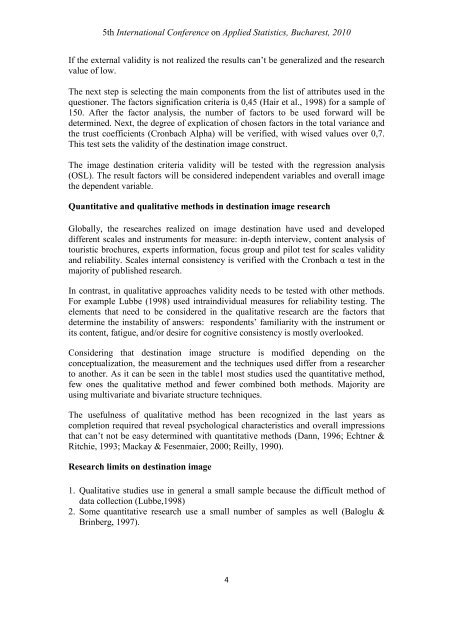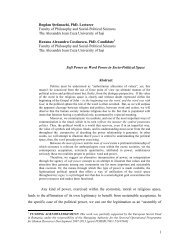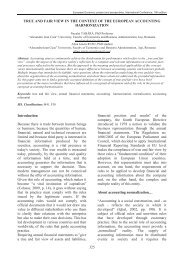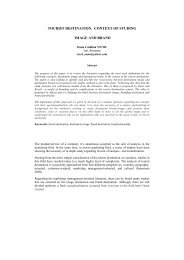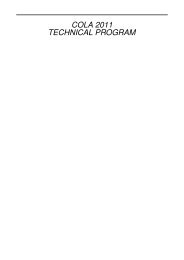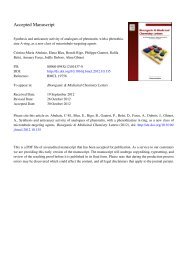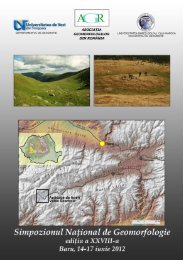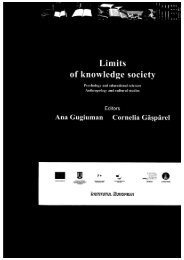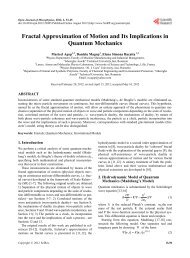Quantitative and qualitative methods used for analyzing destination ...
Quantitative and qualitative methods used for analyzing destination ...
Quantitative and qualitative methods used for analyzing destination ...
Create successful ePaper yourself
Turn your PDF publications into a flip-book with our unique Google optimized e-Paper software.
5th International Conference on Applied Statistics, Bucharest, 2010If the external validity is not realized the results can’t be generalized <strong>and</strong> the researchvalue of low.The next step is selecting the main components from the list of attributes <strong>used</strong> in thequestioner. The factors signification criteria is 0,45 (Hair et al., 1998) <strong>for</strong> a sample of150. After the factor analysis, the number of factors to be <strong>used</strong> <strong>for</strong>ward will bedetermined. Next, the degree of explication of chosen factors in the total variance <strong>and</strong>the trust coefficients (Cronbach Alpha) will be verified, with wised values over 0,7.This test sets the validity of the <strong>destination</strong> image construct.The image <strong>destination</strong> criteria validity will be tested with the regression analysis(OSL). The result factors will be considered independent variables <strong>and</strong> overall imagethe dependent variable.<strong>Quantitative</strong> <strong>and</strong> <strong>qualitative</strong> <strong>methods</strong> in <strong>destination</strong> image researchGlobally, the researches realized on image <strong>destination</strong> have <strong>used</strong> <strong>and</strong> developeddifferent scales <strong>and</strong> instruments <strong>for</strong> measure: in-depth interview, content analysis oftouristic brochures, experts in<strong>for</strong>mation, focus group <strong>and</strong> pilot test <strong>for</strong> scales validity<strong>and</strong> reliability. Scales internal consistency is verified with the Cronbach α test in themajority of published research.In contrast, in <strong>qualitative</strong> approaches validity needs to be tested with other <strong>methods</strong>.For example Lubbe (1998) <strong>used</strong> intraindividual measures <strong>for</strong> reliability testing. Theelements that need to be considered in the <strong>qualitative</strong> research are the factors thatdetermine the instability of answers: respondents’ familiarity with the instrument orits content, fatigue, <strong>and</strong>/or desire <strong>for</strong> cognitive consistency is mostly overlooked.Considering that <strong>destination</strong> image structure is modified depending on theconceptualization, the measurement <strong>and</strong> the techniques <strong>used</strong> differ from a researcherto another. As it can be seen in the table1 most studies <strong>used</strong> the quantitative method,few ones the <strong>qualitative</strong> method <strong>and</strong> fewer combined both <strong>methods</strong>. Majority areusing multivariate <strong>and</strong> bivariate structure techniques.The usefulness of <strong>qualitative</strong> method has been recognized in the last years ascompletion required that reveal psychological characteristics <strong>and</strong> overall impressionsthat can’t not be easy determined with quantitative <strong>methods</strong> (Dann, 1996; Echtner &Ritchie, 1993; Mackay & Fesenmaier, 2000; Reilly, 1990).Research limits on <strong>destination</strong> image1. Qualitative studies use in general a small sample because the difficult method ofdata collection (Lubbe,1998)2. Some quantitative research use a small number of samples as well (Baloglu &Brinberg, 1997).4


